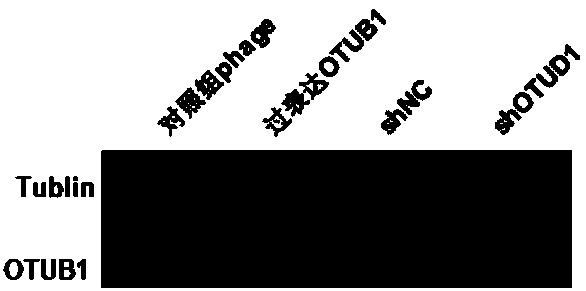Application of OTU Domain-Containing Deubiquitinase 1 in preparation of medicines for treating fatty liver and related diseases
A technology for deubiquitinating enzymes and functional domains, used in the preparation of drugs for preventing, relieving and/or treating fatty liver, in the field of deubiquitinating enzymes, and achieving high safety effects
- Summary
- Abstract
- Description
- Claims
- Application Information
AI Technical Summary
Problems solved by technology
Method used
Image
Examples
Embodiment 1
[0101] [Example 1] Establishment of L02 cell line stably transfected with OTUD1
[0102] According to the steps of establishing the L02 stable transfection cell line in the embodiment, the L02 stable transfection cell line with OTUD1 overexpression and knockdown was established. Afterwards, the cells were collected, and the expression of OTUD1 was verified by WB. The result is as figure 1 As shown, in L02 cells infected with OTUD1 overexpression lentivirus system, the expression of OTUD1 was significantly increased; in L02 cells infected with OTUD1 knockdown lentivirus system, the expression of OTUD1 was significantly decreased, indicating that the cell line was successfully established.
Embodiment 2
[0103] [Example 2] Effect of OTUD1 knockdown on fat accumulation in liver cells
[0104] (1) Grouping of experimental cells: normal L02 cell control group, OTUD1 stable knockdown L02 cell control group, normal L02 cell experimental group, and OTUD1 stable knockdown L02 cell experimental group.
[0105](2) Establishment and detection of fatty liver cell model: as soon as the cells adhere to the wall, after the cells are cultured to 50% healing, add palmitate (PA) and oleic acid (OA) (PA 0.2mM +OA 0.4 mM) for stimulation, the same amount of BSA was added to the control group, and the cell samples of each group were collected after 12 hours for Oil Red O staining.
[0106] The results of Oil Red O staining were as follows: figure 2 As shown, the cells in the control group had no obvious red color, and the area of red fat droplets in the cells of the experimental group was significantly increased after adding PA+OA stimulation, and the area of red fat droplets in the OTUD1 s...
Embodiment 3
[0107] [Example 3] Effect of OTUD1 overexpression on fat accumulation in liver cells
[0108] 1. Experimental cell grouping: normal L02 cell control group, OTUD1 stable overexpression L02 cell control group, normal L02 cell experimental group, OTUD1 stable overexpression L02 cell experimental group.
[0109] 2. Establishment and detection of fatty liver cell model: After the cells adhere to the wall and the cells are cultured to 50% healing, add palmitate (PA) and oleic acid (OA) (PA 0.2mM+OA) to the two experimental groups 0.4mM) stimulation, the same amount of BSA was added to the control group, and the cell samples of each group were collected after 12h for Oil Red O staining.
[0110] The results of Oil Red O staining were as follows: image 3 As shown, the cells in the control group had no obvious red color, and when the experimental group was stimulated by adding PA+OA, the cells in the area of red fat droplets in the experimental group were significantly increased co...
PUM
 Login to View More
Login to View More Abstract
Description
Claims
Application Information
 Login to View More
Login to View More - R&D
- Intellectual Property
- Life Sciences
- Materials
- Tech Scout
- Unparalleled Data Quality
- Higher Quality Content
- 60% Fewer Hallucinations
Browse by: Latest US Patents, China's latest patents, Technical Efficacy Thesaurus, Application Domain, Technology Topic, Popular Technical Reports.
© 2025 PatSnap. All rights reserved.Legal|Privacy policy|Modern Slavery Act Transparency Statement|Sitemap|About US| Contact US: help@patsnap.com



